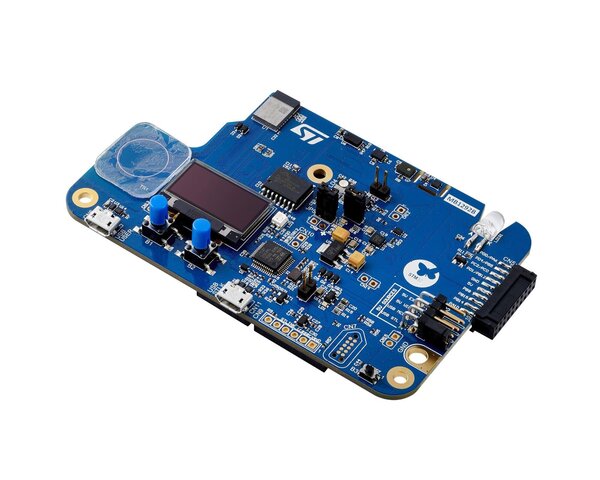ST STM32WB5MM-DK
Overview
The STM32WB5MM-DK Discovery kit is designed as a complete demonstration and development platform for the STMicroelectronics STM32W5MMG module based on the Arm® Cortex®-M4 and Arm® Cortex®-M0+ cores. The STM32 device is a multi-protocol wireless and ultra-low-power device embedding a powerful and ultra-low-power radio compliant with the Bluetooth® Low Energy (BLE) SIG specification v5.2 and with IEEE 802.15.4-2011.
STM32WB5MM-DK supports the following features:
- STM32WB5MMG (1-Mbyte Flash memory, 256-Kbyte SRAM)
Dual-core 32‑bit (Arm® Cortex®-M4 and M0+)
2.4 GHz RF transceiver
0.96-inch 128x64 OLED display
128-Mbit Quad-SPI NOR Flash Memory
Temperature sensor
Accelerometer/gyroscope sensor
Time-of-Flight and gesture-detection sensor
Digital microphone
RGB LED
Infrared LED
3 push-buttons (2 users and 1 reset) and 1 touch key button
- Board connectors:
STMod+
ARDUINO® Uno V3 expansion connector
USB user with Micro-B connector
TAG10 10-pin footprint
- Flexible power-supply options:
ST-LINK/V2-1 USB connector,
- 5 V delivered by:
ARDUINO®,
external connector,
USB charger, or USB power
- On-board ST-LINK/V2-1 debugger/programmer with USB re-enumeration
Virtual COM port and debug port

More information about the board can be found in STM32WB5MM-DK on www.st.com.
Hardware
STM32WB5MMG is an ultra-low-power and small form factor certified 2.4 GHz wireless module. It supports Bluetooth® Low Energy 5.4, Zigbee® 3.0, OpenThread, dynamic, and static concurrent modes, and 802.15.4 proprietary protocols.
Based on the STMicroelectronics STM32WB55VGY wireless microcontroller, STM32WB5MMG provides best-in-class RF performance thanks to its high receiver sensitivity and output power signal. Its low-power features enable extended battery life, small coin-cell batteries, and energy harvesting.
Ultra-low-power with FlexPowerControl
Core: ARM® 32-bit Cortex®-M4 CPU with FPU
Radio:
2.4GHz
RF transceiver supporting:
Bluetooth® 5.4 specification,
IEEE 802.15.4-2011 PHY and MAC,
Zigbee® 3.0
RX sensitivity:
-96 dBm (Bluetooth® Low Energy at 1 Mbps),
-100 dBm (802.15.4)
Programmable output power up to +6 dBm with 1 dB steps
Integrated balun to reduce BOM
Support for 2 Mbps
Support GATT caching
Support EATT (enhanced ATT)
Support advertising extension
Accurate RSSI to enable power control
Clock Sources:
32 MHz crystal oscillator with integrated trimming capacitors (Radio and CPU clock)
32 kHz crystal oscillator for RTC (LSE)
Internal low-power 32 kHz (±5%) RC (LSI1)
Internal low-power 32 kHz (stability ±500 ppm) RC (LSI2)
Internal multispeed 100 kHz to 48 MHz oscillator, auto-trimmed by LSE (better than ±0.25% accuracy)
High speed internal 16 MHz factory trimmed RC (±1%)
2x PLL for system clock, USB, SAI, ADC
More information about STM32WB55RG can be found here:
Supported Features
The Zephyr STM32WB5MM-DK board configuration supports the following hardware features:
Interface |
Controller |
Driver/Component |
|---|---|---|
UART |
on-chip |
serial port-polling; serial port-interrupt |
I2C |
on-chip |
i2c |
Other hardware features are not yet supported on this Zephyr port.
The default configuration can be found in the defconfig file: boards/st/stm32wb5mm_dk/stm32wb5mm_dk_defconfig
Bluetooth and compatibility with STM32WB Copro Wireless Binaries
To operate bluetooth on STM32WB5MMG, Cortex-M0 core should be flashed with
a valid STM32WB Coprocessor binaries (either ‘Full stack’ or ‘HCI Layer’).
These binaries are delivered in STM32WB Cube packages, under
Projects/STM32WB_Copro_Wireless_Binaries/STM32WB5x/.
For compatibility information with the various versions of these binaries,
please check modules/hal/stm32/lib/stm32wb/hci/README
in the hal_stm32 repo.
Note that since STM32WB Cube package V1.13.2, “full stack” binaries are not compatible anymore for a use in Zephyr and only “HCI Only” versions should be used on the M0 side.
Connections and IOs
Default Zephyr Peripheral Mapping:
UART_1 TX/RX : PB7/PB6 ( Connected to ST-Link VCP)
LPUART_1 TX/RX : PA3/PA2
USB : PA11/PA12
SWD : PA13/PA14
I2C3: SDA/SCL PB11/PB13 (Sensor I2C bus)
System Clock
STM32WB5MMG System Clock could be driven by internal or external oscillator, as well as main PLL clock. By default System clock is driven by HSE clock at 32MHz.
Serial Port
STM32WB5MM-DK board has 2 (LP)U(S)ARTs. The Zephyr console output is assigned to USART1.
Default settings are 115200 8N1.
LEDs
STM32WB5MM-DK has two types of LEDs, The resources coming from STM32WB5MMG are shared between the RGB and IR LEDs. It is not possible to use them simultaneously. The selection is done by JP4 and JP5 jumpers. To use the RGB LED, JP5 must be ON and JP4 OFF. In this configuration, GPIO_SELECT2 (PH1) is the chip select for this RGB device on SPI1.
Programming and Debugging
STM32WB5MM-DK has an on-board ST-Link to flash and debug the firmware on the module.
Applications for the stm32wb5mm_dk board configuration can be built the
usual way (see Building an Application).
Flashing
The board is configured to be flashed using west STM32CubeProgrammer runner, so its installation is required.
Alternatively, OpenOCD or pyOCD can also be used to flash the board using
the --runner (or -r) option:
$ west flash --runner openocd
$ west flash --runner pyocd
Flashing hello_world application to STM32WB5MM-DK
Connect the STM32WB5MM-DK to your host computer using the USB port (CN11).
Then build and flash an application. Here is an example for the hello_world
application.
Run a serial host program to connect with your STM32WB5MM-DK board:
$ minicom -D /dev/ttyACM0
Then first build and flash the application for the STM32WB5MM-DK board.
# From the root of the zephyr repository
west build -b stm32wb5mm_dk samples/hello_world
west flash
Reset the board and you should see the following messages on the console:
Hello World! stm32w5mm_dk
Debugging
You can debug an application in the usual way. Here is an example for the Hello_World application.
# From the root of the zephyr repository
west build -b stm32wb5mm_dk samples/hello_world
west debug
